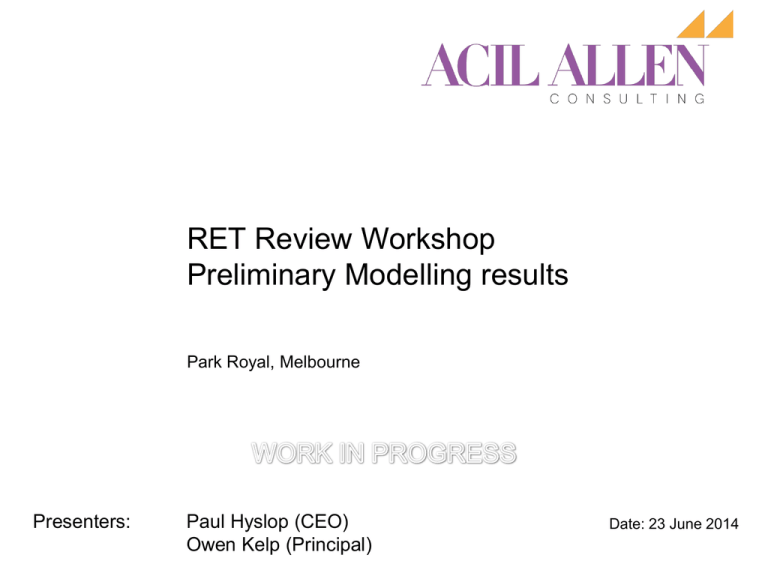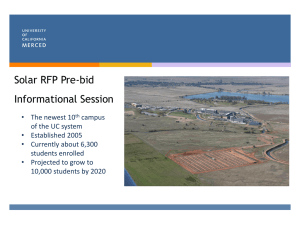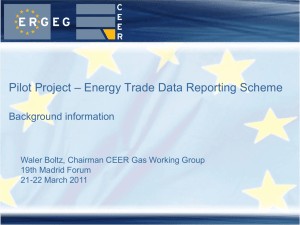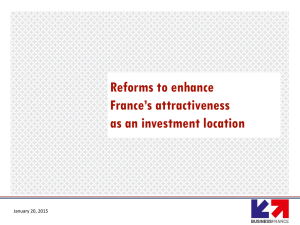PPT 1.6MB - RET Review
advertisement

RET Review Workshop Preliminary Modelling results Park Royal, Melbourne Presenters: Paul Hyslop (CEO) Owen Kelp (Principal) Date: 23 June 2014 Disclaimer The materials provided in this presentation have been prepared by ACIL Allen Consulting for the exclusive purpose of providing advice to the RET Review Panel. This materials are supplied in good faith and reflect the knowledge, expertise and experience of the consultants involved. In conducting the analysis in these materials ACIL Allen Consulting has endeavoured to use what it considers is the best information available at the date of publication, including information supplied by various government agencies, AEMO and the IMOWA. ACIL Allen Consulting does not warrant the accuracy of any forecast or prediction in the materials. Although ACIL Allen Consulting exercises reasonable care when making forecasts or predictions, factors in the process, such as consumer demand and future market behaviour, are inherently uncertain and cannot be forecast or predicted reliably. ACIL Allen Consulting accepts no responsibility whatsoever for any loss occasioned by any person acting or refraining from action as a result of reliance on the materials. Slide 2 Preliminary comments Market modelling and projections are an important input into the Expert Panel’s deliberations on the 2014 RET Review ACIL Allen Consulting (ACIL Allen) engaged to undertake this modelling and analysis Assessing costs and benefits from the analysis Incremental capital and operating costs versus abatement End use tariff effects – certificate costs and projected changes in wholesale prices/network tariffs No economy wide analysis – i.e. effect on economy of subsidising large volumes of renewable investment into the electricity sector Cost of incremental factors of production Changes in end use tariff effects Effects on GDP and real income Slide 3 Wholesale price uncertainty Wholesale prices are not able to be forecast accurately Inherent uncertainties in inputs and market behaviour - distribution of likely outcomes Example simulation below (462 simulations with variations in weather, plant performance and market behaviour) Floor on prices determined by underlying marginal costs Range of prices determined by variation in demand, plant performance and behaviour ACIL Allen approach – projections based on 50th percentile Distribution will tend to be compressed in oversupplied market/falling demand environment Wholesale price benefits are highly dependent on projected market conditions, projected plant performance and market behaviour While increased supply would be expected to reduce wholesale prices, this effect is inherently uncertain Slide 4 Introduction and overview Initial assumptions workshop held 23 April in Sydney Purpose of today’s workshop is to provide stakeholders with: A description of the modelling approach/assumptions used An overview of policy scenarios and sensitivities modelled A summary of the key results from the modelling and impacts Slide 5 Recap of modelling approach Modelling Australian electricity grids over the period 2014 to 2040 National Electricity Market (NEM) WA Wholesale Electricity Market (WEM) North West Interconnected System (NWIS) Darwin Katherine Interconnected System (DKIS) Mt Isa system Assessment of demand outside these grids Large-scale Renewable Energy Target (LRET) Small-scale Renewable Energy Scheme (SRES) Slide 6 Recap of modelling approach (cont.) ACIL Allen has utilised three key models: PowerMark LT SRES projection model Retail price model PowerMark LT is a long-term dynamic least cost planning model Models all grids simultaneously as well as Australia-wide policy settings Incorporates and models the LRET explicitly Utilised our PowerMark simulation model in conjunction with LT SRES projection model Projects uptake of small-scale PV systems based on historical relationships of installs against system financial paybacks Retail price model Bottom-up build of retail cost components: network (TUOS & DUOS), wholesale energy, LRET, SRES, losses, green scheme costs, metering charges, retail operating costs, pool fees, ancillary service costs, retail margin. Slide 7 Scenarios modelled Policy cases Reference case (current policy) Repeal case Scheme closed to new entrants Real 20% by 2020 Real 30% by 2030 Sensitivities Demand Carbon Capital costs Fuel costs Other Policy cases/sensitivities may also be examined Slide 8 Reference case (current policy) Reference case (current policy) LRET target of 41,000 GWh by 2020 SRES uncapped; 15 year deeming solar PV; 10 year SWH ● Deeming periods limited to end of scheme in 2030 AEMO / IMO energy forecasts from 2014; growth rates for other grids taken from 2013 emission projection work Carbon repealed from 1 July 2014 Midline assumptions on all inputs Slide 9 Repeal and Closed to new entrant cases Repeal case Both LRET and SRES cease from 1 January 2015 Closed to new entrants SRES cease from 1 January 2015 ● Some transitional arrangements if excess STCs created in 2014 LRET remains: eligibility to create LGCs limited to large-scale projects already accredited, under construction or fully committed Modelled using a fixed price of $40/LGC (Nominal) Slide 10 Real 20% by 2020 Settings: SRES ceases earlier with 2020 the last compliance year ● Solar PV deeming lowered from 15 to 10 years from 1 Jan 2015 (remains fixed at 10 years until 2020) LRET target reset to achieve 20% renewables share of energy mix in 2020 ● Calculated through the following formula: • • • • ● RESRES PV = 9,272 GWh (energy generated from behind the meter solar PV systems) REPRE-RET = 16,148 GWh (existing baseline generation) ENEM + ESWIS + PVNEM&SWIS + EOther&Offgrid = 255,376 GWh %RE2020 = 20% Solving for RELRET Eligible = 25,655 (rounded to 25,500 GWh) Calculation excludes energy displaced from solar water heaters and voluntary schemes such as GreenPower Slide 11 Real 30% by 2030 Settings: No change to SRES (remains uncapped and scheme terminates in 2030) Extension of LRET to 2040, linear annual targets from 2015 to 2030 LRET target reset to achieve 30% renewables share of energy mix in 2030 ● ● ● Uses the same formula as in the Real 20% case Where: • RESRES PV = 15,188 GWh (energy generated from behind the meter solar PV systems) • REPRE-RET = 16,148 GWh (existing baseline generation) • ENEM + ESWIS + PVNEM&SWIS + EOther&Offgrid = 281,260 GWh • %RE2030 = 30% Solving for RELRET Eligible = 53,042 (rounded to 53,000 GWh) Calculation excludes energy displaced from solar water heaters and voluntary schemes such as GreenPower Slide 12 Scenarios modelled LRET annual profiles Mandatory large-scale renewable energy targets Note: Values exclude existing 850GWh waste coal mine gas allowance. Repeal case has no target from 2015 onwards. Closed to new entrants target profile shows projected LGC creation from existing and committed large-scale projects. Slide 13 Key assumptions: Demand Grid / demand segment Updated forecasts provided by AEMO/IMO Significant downward revision for NEM Largely no change from IMO for the SWIS Australian electricity demand NEM SWIS NWIS DKIS Mt Isa Solar PV Embedded/self-gen Off-grid Av erage annual Demand 2014 181.4 18.5 2.9 1.6 2.3 4.7 10.3 10.9 232.7 2020 191.1 20.9 3.6 1.8 2.5 9.2 11.2 15.1 255.4 2040 205.6 29.6 4.9 2.9 4.0 20.3 13.9 20.4 301.6 grow th rate 2014-40 0.5% 1.8% 2.0% 2.2% 2.2% 5.8% 1.2% 2.5% 1.0% Energy values for NEM and SWIS provided by AEMO, IMO but adjusted for non-scheduled generation, modified for projected PV uptake and converted to calendar year basis Comprehensive picture of Australian electricity demand compiled Total is significantly lower than BREE 2012 publication 2020 energy: 255 TWh (BREE 298 TWh) Slide 14 Key assumptions: Fossil fuel costs Gas prices based on international netback series (IEA 2013 Gas Convergence case) All existing generators transition on to these prices over the next 2-3 years (reflecting opportunity costs of gas even if under legacy contracts) Regional differences based on transportation costs differentials Coal costs based on ACIL Allen assumptions, reflecting long run international coal prices of $80-90/tonne real Given muted demand growth in the NEM, neither materially impact results nationally Slide 15 Key assumptions: Capital costs and carbon Capital cost draws from 2012 Australian Energy Technology Assessment (AETA) published by the Bureau of Resource and Energy Economics (BREE) Using the 2013 AETA update to various elements Slight downward revisions to starting capital costs for solar PV and wind, slight increase to gasfired CCGT, OCGT were made based on recent project experience and stakeholder feedback Cost declines for small-scale linked to utility solar With adjustments for higher local and labour content No carbon policy for base scenarios Carbon policy impact tested in sensitivities Slide 16 Results Results from Reference case and Policy scenarios Renewable energy uptake/investment Impacts on electricity market participants Aggregate generation costs Calculated cost of abatement Projected electricity price impacts for users Sensitivity results Low demand Carbon Slide 17 Renewable Energy Uptake New capacity by technology in 2020, 2030 and 2040 (MW) Small-scale solar PV represents <100kW installations Note: Other renewable technologies such as biomass and geothermal not shown, but account for a very small proportion of development. Figures exclude projects committed or under construction as these are treated as existing capacity. Slide 18 Renewable Energy Uptake (cont.) Impact of Repeal of RET on small-scale Short-term impact on install rate of around 30% However declining deeming period from 2017 reduces impact of SRES on system paybacks to customers Approaching 2030 install rates are slightly higher than Reference due to higher retail electricity prices Slide 19 Renewable Energy Uptake (cont.) Renewable energy share of electricity: Reference case Renewable energy in Australia Note: Excludes energy displaced from solar water heaters, Renewable energy associated with GreenPower and other voluntary LGC surrender volumes (e.g. desalination) Slide 20 Renewable Energy Investment New capital investment by generation technology (cumulative Real 2014 $m) Note: Small-scale solar PV represents <100kW installations. Capital expenditure for wind and utility-scale solar PV pro-rated down based on proportion of useful life modelled Slide 21 Generation mix Generation by technology: Reference case Note: Excludes non-scheduled generation in NEM regions, own-generation in the SWIS, off-grid generation and rooftop solar in all regions. ‘Other’ category includes cogeneration, liquid fuels, CCS-equipped technologies, biomass and geothermal. Slide 22 Generation mix change Impact of RET repeal on dispatch outcomes Wind and solar generation displace coal and gas-based generation Note: Excludes non-scheduled generation in NEM regions, own-generation in the SWIS, off-grid generation and rooftop solar in all regions. ‘Other’ category includes cogeneration, liquid fuels, CCS-equipped technologies, biomass and geothermal. Slide 23 New entrant capacity New entrant capacity: Reference case Virtually all new entrant capacity is renewable to 2025 (7,600MW wind; 1000MW solar PV) Some fossil fuel entry from 2025 onward once LRET is met Note: Excludes non-scheduled generation in NEM regions, own-generation in the SWIS, off-grid generation and rooftop solar in all regions. ‘Other’ category includes cogeneration, liquid fuels, CCS-equipped technologies, biomass and geothermal. Slide 24 New entrant capacity change Impact on new entrant capacity of Repeal: (Repeal - Reference) 8,000 MW less capacity is added due to repeal of LRET Note: Excludes non-scheduled generation in NEM regions, own-generation in the SWIS, off-grid generation and rooftop solar in all regions. ‘Other’ category includes cogeneration, liquid fuels, CCS-equipped technologies, biomass and geothermal. Slide 25 Mothballed capacity Most of the current mothballed coal capacity projected to come back to service over the next couple of years A result of carbon repeal and lower gas plant utilisation Around 1,200 MW of capacity withdrawn from market under Reference case (relative to Repeal case) This dampens wholesale price suppression effect of renewables Incumbent plant will not operate if not covering fixed O&M costs from pool revenues Less capacity withdrawn under lower/slower ramped LRET Slide 26 Aggregate generation costs Total expenditure on electricity generation by expenditure category Also sometimes referred to as sector resource cost NPV = $12.8 billion Note: Excludes non-scheduled generation in NEM regions, own-generation in the SWIS, off-grid generation. Capital and refurbishment costs are pro-rated down when modelling period does not cover economic life. NPV calculation uses a 7% real discount rate Slide 27 Wholesale price impact Impact of repeal of RET on wholesale price outcomes Note: Weighted average wholesale energy price for NEM and Other modelled grids (SWIS, NWIS, DKIS and Mt Isa) Slide 28 Wholesale price impact Projected national weighted-average wholesale energy price Note: National weighted average wholesale energy price. Prices under the ‘Closed to new entrants’ case are the same as the Repeal case Slide 29 Emissions/intensity: Reference case Note: Average emissions intensity for modelled grids. Excludes non-scheduled generation in NEM regions, own-generation in the SWIS, off-grid generation. Slide 30 Impact of continuing the RET on emissions Note: Average emissions intensity for modelled grids. Excludes non-scheduled generation in NEM regions, own-generation in the SWIS, off-grid generation. Slide 31 Emissions outcomes across scenarios Comparison across scenarios of annual and cumulative electricity emissions in 2020, 2030 and 2040 Emissions (Mt CO2-e) 2020 166.2 190.0 190.0 181.4 174.6 2030 179.4 203.0 203.0 194.2 171.7 2040 190.2 211.9 211.9 204.5 178.5 Change from Reference case 2020 2030 2040 0.0 0.0 0.0 23.8 23.6 21.7 23.8 23.6 21.7 15.2 14.8 14.3 8.4 -7.7 -11.7 Cumulative emissions (Mt CO2-e) 2015-20 Reference case 1,046 Repeal case 1,108 Closed to new entrants 1,108 Real 20% by 2020 1,090 Real 30% by 2030 1,077 2015-30 2,760 3,063 3,063 2,959 2,787 2015-40 4,615 5,143 5,143 4,957 4,537 Change from Reference case 2015-20 2015-30 2015-40 0 0 0 62 304 528 62 304 528 43 199 342 31 27 -77 Reference case Repeal case Closed to new entrants Real 20% by 2020 Real 30% by 2030 Note: Excludes non-scheduled generation in NEM regions, own-generation in the SWIS, off-grid generation. Slide 32 Cost of abatement: LRET Comparison of average cost of abatement (2014-40) relative to no policy (Repeal case) NPV of Reference case Real 20% by 2020 Real 30% by 2030 NPV of Sum of resource abatement abatement costs ($m) (Mt CO2-e) (Mt CO2-e) 10,854 3,190 11,090 201 66 202 504 170 587 Abatement cost ($/tonne) Discounting both costs and abatement $54 $48 $55 Note: Discounting costs and abatement method: NPV of resource cost / NPV of abatement achieved. Calculation presented uses a 7% real discount rate over the period 2014 to 2040 Slide 33 Cost of abatement: SRES (solar PV only) Comparison of average cost of abatement (2014-40) relative to no policy (Repeal case) NPV of Reference case Real 20% by 2020 Real 30% by 2030 NPV of Sum of resource abatement abatement costs ($m) (Mt CO2-e) (Mt CO2-e) 1,972 1,252 1,745 11 7 9 25 16 19 Abatement cost ($/tonne) Discounting both costs and abatement $186 $176 $190 Note: Discounting costs and abatement method: NPV of resource cost / NPV of abatement achieved. Calculation presented uses a 7% real discount rate over the period 2014 to 2040 Slide 34 Electricity price impacts for users National weighted average electricity prices: Reference case Residential customer: 5.9-8.3 MWh per year (varies across networks) Commercial customer: 2,900 MWh per year Industrial customer: 6-10 GWh per year EITE: very large Slide 35 Certificate prices across scenarios Modelled annual prices required to ensure renewable projects are commercially viable Note: LGC prices under ‘Closed to new entrants’ scenario assumes a fixed $40/LGC (nominal) price. Projected prices from the model assume that the scenario settings are known with perfect certainty and prices immediately adjust which explains why prices are well above current levels for 2014. Slide 36 Certificate costs for users: Reference case Note: Assumes wholesale prices changes flow through to users. Costs to EITE users may not reflect actual costs due to existing contracts Slide 37 Certificate costs to users Cumulative certificate costs across all scenarios (Real $2014) Slide 38 Net impact on annual household bills Household bills are initially higher with the RET but lower in the longer-term Wealth transfer from consumers to renewables 2015-2020 Wealth transfer from other generators to renewables and consumers 2021-2030 Note: National weighted average based on average household consumption of 6.8 MWh Slide 39 Net impact of policy on household bills Comparison of impact on typical annual household electricity bills across scenarios (real $2014) Annual change to household bills from various RET policies (Real 2014 $/year) Av erage Reference case Repeal case Closed to new entrants Real 20% by 2020 Real 30% by 2030 2015-20 $54 $0 $23 $50 $47 2020 $7 $0 $21 $31 -$32 Av erage 2021-30 -$56 $0 $17 -$24 -$109 Annual change to household bills from various RET policies (Real 2014 $/year) 2030 -$91 $0 $15 -$78 -$158 NPV of change to household bills from various RET policies ($) Reference case Repeal case Closed to new entrants Real 20% by 2020 Real 30% by 2030 2015-20 $290 $0 $119 $255 $255 2015-30 -$160 $0 $195 $66 -$569 Note: National weighted average based on average household consumption of 6.8 MWh. NPV calculated using a 7% real discount rate Slide 40 Summary of impacts for users RET compliance costs directly increase electricity costs for consumers This can be offset by the suppressing affect on wholesale electricity prices in the longer-term Short-term it has no additional impact (beyond the impact of pre-existing renewables driven by the RET) as the renewable capital stock is fixed Renewable entry effect on wholesale prices will be dependent upon market conditions Renewables are less likely to have any material impact in strong demand growth or declining demand conditions However, resulting price changes are largely wealth transfers between market participants and do not necessarily reflect efficienct prices Policy objectives should maximise welfare and ensure consumers see efficient, cost reflective prices Economic benefits do not usually include wealth transfers where either producers or consumers benefit at the expense of each other Slide 41 Sensitivities Sensitivities have been run for lower electricity demand and for a shadow carbon price Lower electricity demand utilises low economic growth scenarios from AEMO/IMO and holds off-grid/embedded generation flat Reference case, Real 20% and Real 30% A Carbon shadow price is assumed to be linked to European permits and commencing in 2021: price is around A$9.50/tonne CO2-e, escalating at 3% real Reference case, Repeal and Closed to New Entrants Slide 42 Low demand: Change in Reference case This shows the impact of lower demand, holding RET policy constant Significant incumbent coal retirements occur which dampens price suppression Lower coal, baseload gas and utility solar generation No real change to wind, hydro and peaking gas generation LRET still met (slightly higher LGC price) Lower wholesale prices but higher retail prices (higher RPP and STP values) Lower emissions, due primarily to coal retirements Slide 43 Low demand: Real 20% - Reference Shows impact of reducing RET down to a real 20% in low demand environment Little wholesale price effect – RET simply alters retirement timing Switch in retail prices occurs in late 2020s rather than ~2020 Early benefits to household users from reducing the RET last longer Highlights uncertainty in price outcomes Change in capacity and generation similar to the central scenarios Slide 44 Low demand: Real 30% - Reference Shows impact of modifying RET to a real 30% in 2030 in low demand environment Little wholesale price effect – RET simply alters retirement timing Increased solar development in regional grids flattens longer-term prices Lower direct costs initially (lower RPP), but extension of scheme to 2040 results in direct costs lasting longer Deferred wind build, but more wind, solar long-term Slide 45 Shadow Carbon Price: Change in Reference case Shows the impact of a shadow carbon price under the Reference case Relatively low carbon price has some impact on generation mix at the margin Black coal, wind and baseload gas displace brown coal from 2021 Emissions reduced after introduction of shadow price after 2020 LRET still met slightly lower LGC price due to higher wholesale prices Slide 46 Shadow Carbon Price: Repeal - Reference Impacts of Repeal and closing to new entrants are similar to the central scenarios The RET reduces emissions throughout the projection period with the shadow price used (emissions are persistently lower in the reference case than in the repeal case) Although abatement achieved due to RET diminishes over time Slide 47 Next steps Completion of sensitivity modelling Panel to consider the feedback from this workshop Further scenario/sensitivity modelling as requested by the Panel Modelling report to accompany the Expert Panel report to Government Slide 48 Logo Acil Allen Logo ACIL Allen Consulting Pty Ltd www.acilallen.com.au Slide 49










